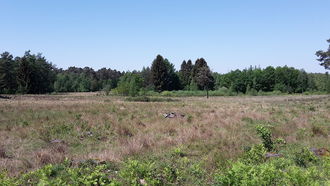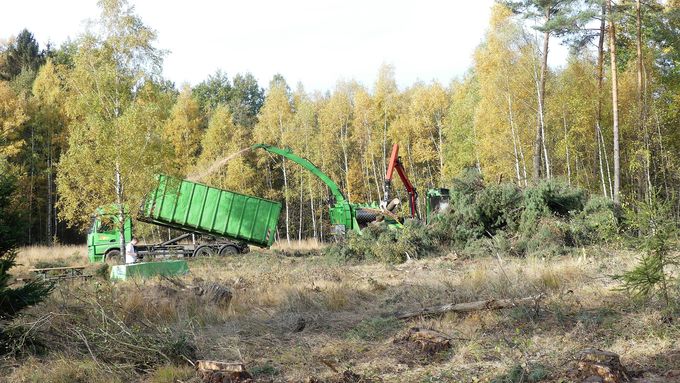Further such open heath areas are to be created by the measures in the ‘Ohligser Heide’. © Corinna Kaiser, Bezirksregierung Münster
download picturemain content
Project of the month
#03/2020 AREA OPTIMIZATION AND EXPANSION OF WET HEATHS AND BOG WOODLAND
Heath Restoration in the SAC ‘Ohligser Heide’
Only about 100 years ago, the ‘Ohligser Heide’ near Solingen, as part of the ‘northern heath terrace’, was a large heath area with interspersed moorlands. As early as 1936, an area of around 28 hectares was secured as a nature reserve and then gradually expanded. However, the designation as a protected area could not prevent that the condition of the valuable habitat types deteriorated significantly until the 1970s.
Formerly extensively cultivated landscapes such as heaths and other open landscapes used by man require regular landscape management in order to be preserved and to retain the plant and animal species specialised to these conditions. Without interventions, such habitats would develop into forests, and many of the plant and animal species which are typical for the open landscape would disappear. In the forest complexes of the ‘Ohligser Heide’, there are wood species that do not originally occur there, such as poplars, red oaks, black cherry, larch and spruce, which are opposed to the development of the endangered habitat types. In addition to regular landscape management activities, larger interventions, such as extensive clearing or removal of the topsoil, may therefore occasionally be necessary. At first sight, this procedure may appear to be very drastic and disproportionate for laypersons. However, it is necessary for the protection and conservation of many endangered species.
Since the 1980s, appropriate maintenance and development measures have been carried out in the ‘Ohligser Heide’ in order to maintain and further develop a structurally rich mosaic of wet heaths, bog woodland and marshland forest, heath ponds, flowing waters, but also dry heaths, open sand areas and oak-birch forests on the elevated dune areas. Many rare animal and plant species, such as the bog heather (Erica tetralix), the bog asphodel (Narthecium ossifragum) and the long-leaved sundew (Drosera intermedia) have already recovered significantly in their populations. Today the nature reserve covers about 147 hectares. Since 2004, 136 hectares of the nature reserve have also been listed as SAC ‘Ohligser Heide’ (DE-4807-303), among other things for the preservation and development of the yellow-spotted whiteface (Leucorrhinia pectoralis).
Within the framework of the LIFE Integrated Project ‘Atlantic Region DE’, the City of Solingen and the Biological Station Mittlere Wupper have jointly developed a package of measures for the SAC ‘Ohligser Heide’. The birch swamp forests and bog woodlands are in particular focus, as they are threatened by sinking groundwater levels and invading neophytes. In addition, an expansion of the heath areas should be achieved. Although these have been expanded from around one hectare to over 20 hectares in the last three decades, the optimal balance between forest and open land has not yet been fully achieved. Likewise, low-nutrient, sunny standing water bodies are still lacking at present in order to offer a sufficiently large and interconnected habitat to all heath wildlife species. The Biological Station Mittlere Wupper is coordinating the implementation of these measures in the project period 2018 to 2021. Among the areas within the LIFE IP Atlantic Region DE, the ‘Ohligser Heide’ is one of the most southerly regions. The dividing line between the continental and the Atlantic region runs right through the middle of the City of Solingen.
In autumn 2018, a total of about 2.6 hectares on five forest areas were cut or cleared in a first step. Here, an area of around two hectares is to be converted to its original state (wet heath). On the remaining area of the 4.4 hectares, however, birch bog woodland is to be created. The conservation status of the bog woodlands is to be improved by removing non-native woods, such as black cherry (Prunus serotina), and invasive non-native species, such as the Japanese knotweed (Fallopia japonica) or Indian balsam (Impatiens glandulifera).
In a second step, during the past months, nutrient-rich soil was removed from the cleared areas to allow the actual heath development. Even after decades, the seed material is still in the soil and only needs to be exposed in order to develop. The aim is that 26 percent of the area will be open land and 72 percent will remain forested. In two or three years, the desired heather-typical vegetation will hopefully reappear in the form of marsh club moss (Lycopodiella inundata), bog heather, long-leaved sundew and other plants. Until then, two large information boards at the entrances of the nature reserve will explain the measures in this project area.
Related Topics
Further Links
- SAC ‘Ohligser Heide‘ – Landesamt für Natur, Umwelt und Verbraucherschutz Nordrhein-Westfalen (in German) (external link opens in a new window)
- Nature reserve ‘Ohligser Heide‘ – Landesamt für Natur, Umwelt und Verbraucherschutz Nordrhein-Westfalen (in German) (external link opens in a new window)
- Ohligser Heide – Natur erleben NRW (in German) (external link opens in a new window)
- Biologische Station Mittlere Wupper (in German) (external link opens in a new window)
- Lower Nature Conservation Authority of the City of Solingen (in German) (external link opens in a new window)





